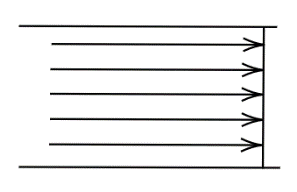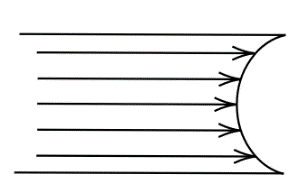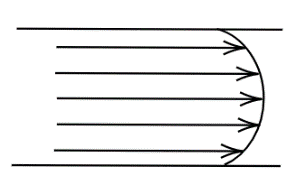
A viscous fluid is flowing through a cylindrical tube. The velocity distribution of the fluid is best represented by the diagram.
A. 
B. 
C. 
D. None of the above
Answer
219k+ views
Hint: The property of a fluid that opposes the relative motion between its different layers is known as viscosity. The force that opposes relative motion between the different layers is known as viscous force.
Complete step by step solution:
Here are three diagrams we have. If we consider the first diagram, it represents the viscous liquid. Viscous liquid means there is a viscous force between the layers of the liquid. The viscous force is comparatively more between solid and liquid layer and as the layers increases in the middle comparatively, the viscous force is less. So, the first option is wrong.
When we consider the second option, near the solid surface, the component of the velocity is more the length is more, and in the middle, the component of velocity is comparatively less. This is also not possible here, at the surface viscous force is more and, in the middle, it is less. Where the viscous force is less there the velocity should be more, but here it is represented as less. Here, the third option represents that, when the viscous force is less, velocity is more and vice versa.
Hence, option C is the correct answer.
Note: Remember that the viscous force and frictional force are similar, but they are not the same. In a moving fluid, the fluid consists of multiple layers. As compared to the neighboring layers each layer has a noticeable difference in speed. This force, called the frictional force, decreases the relative motion between the layers. Viscous force is defined as the force that acts between two layers of a moving fluid.
Complete step by step solution:
Here are three diagrams we have. If we consider the first diagram, it represents the viscous liquid. Viscous liquid means there is a viscous force between the layers of the liquid. The viscous force is comparatively more between solid and liquid layer and as the layers increases in the middle comparatively, the viscous force is less. So, the first option is wrong.
When we consider the second option, near the solid surface, the component of the velocity is more the length is more, and in the middle, the component of velocity is comparatively less. This is also not possible here, at the surface viscous force is more and, in the middle, it is less. Where the viscous force is less there the velocity should be more, but here it is represented as less. Here, the third option represents that, when the viscous force is less, velocity is more and vice versa.
Hence, option C is the correct answer.
Note: Remember that the viscous force and frictional force are similar, but they are not the same. In a moving fluid, the fluid consists of multiple layers. As compared to the neighboring layers each layer has a noticeable difference in speed. This force, called the frictional force, decreases the relative motion between the layers. Viscous force is defined as the force that acts between two layers of a moving fluid.
Recently Updated Pages
Two discs which are rotating about their respective class 11 physics JEE_Main

A ladder rests against a frictionless vertical wall class 11 physics JEE_Main

Two simple pendulums of lengths 1 m and 16 m respectively class 11 physics JEE_Main

The slopes of isothermal and adiabatic curves are related class 11 physics JEE_Main

A trolly falling freely on an inclined plane as shown class 11 physics JEE_Main

The masses M1 and M2M2 M1 are released from rest Using class 11 physics JEE_Main

Trending doubts
JEE Main 2026: Application Form Open, Exam Dates, Syllabus, Eligibility & Question Papers

Understanding Uniform Acceleration in Physics

Derivation of Equation of Trajectory Explained for Students

Hybridisation in Chemistry – Concept, Types & Applications

Understanding the Angle of Deviation in a Prism

Understanding Collisions: Types and Examples for Students

Other Pages
JEE Advanced Marks vs Ranks 2025: Understanding Category-wise Qualifying Marks and Previous Year Cut-offs

Units And Measurements Class 11 Physics Chapter 1 CBSE Notes - 2025-26

NCERT Solutions For Class 11 Physics Chapter 8 Mechanical Properties Of Solids

Motion in a Straight Line Class 11 Physics Chapter 2 CBSE Notes - 2025-26

NCERT Solutions for Class 11 Physics Chapter 7 Gravitation 2025-26

Understanding Atomic Structure for Beginners




